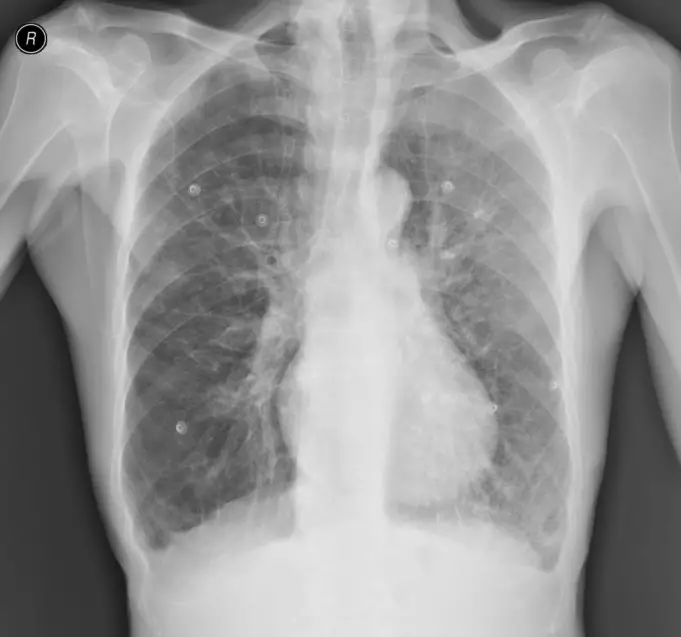Emphysema is a form of chronic lung disease that affects the air sacs (alveoli) of the lungs. Emphysema, as well as bronchitis, are lung conditions known as chronic obstructive pulmonary disease.
Emphysema causes the air sacs in the lungs to become damaged and stretched over time, resulting in chronic cough and difficulty breathing.
The air sacs are small, fragile, and thin-walled pockets of air located at the end of the bronchial tubes inside the lungs. There are about 300 million air sacs in healthy lungs.
Inhaling air causes the alveoli to stretch, drawing in oxygen and transporting it to the blood. When you breathe out, the air sacs shrink, which forces carbon dioxide, a waste product, out of the body.
Emphysema causes these air sacs and lung tissues to be destroyed; as such, the air sacs can no longer support the bronchial tubes. The air sacs become enlarged at the end of the tubes because they are narrowed, stretched, collapsed, or over-inflated.
The collapse of the tube causes a blockage that traps air inside the lungs. This causes a barrel-chested appearance in people who suffer from the condition.
Fewer and larger air sacs mean there is a reduced surface area between the exchange of oxygen in the blood and the carbon dioxide out of it. Emphysema causes permanent damage to the lungs, and the ability to breathe correctly cannot be completely recovered.
Smoking is the most common cause of the disease, although it has also been linked to genetic factors. Emphysema is characterized by shortness of breath, cough, and sometimes fatigue.
The diagnosis of this condition is by lung function tests to measure the capacity of the lungs. Treatment does not reverse the damage already done; it only keeps it from getting worse.
Treatment includes the use of medications and inhalers, respiratory assistance, and in some cases, surgery. According to the Centers for Disease Control and Prevention, about 3.5 million people in the United States (U.S.) were diagnosed with the disease in 2016.
It has been estimated that about 11 million Americans have chronic obstructive pulmonary disease. Emphysema is common amongst men between the ages of 50 and 70.
Causes and Risk Factors of Emphysema
Long-term exposure to air irritants is the primary cause of emphysema. These include:
- Tobacco smoke
- Air pollution
- Particulate matter
- Marijuana smoke
- Chemical fumes and dust
Although rare, the condition can be caused by a hereditary deficiency of alpha-1-antitrypsin, a protein that protects the elastic structures of the lungs.
Factors that increase one’s risk of developing emphysema include:
- Smoking: Cigarette smokers are most likely to develop emphysema. This risk increases over time, and the amount of tobacco smoked for all types of smokers.
- Age: Many people with emphysema begin to experience symptoms of the condition between the ages of 40 and 60.
- Secondhand smoke: Exposure to secondhand smoke may put one at risk of developing the disease. Secondhand smoke, also known as passive smoke, is the smoke unintentionally inhale from someone else’s cigarette or pipe.
- Occupational exposure: You could be exposed to fumes from chemicals or dust from cotton, grains, or mining products. This could put you at risk of developing the disease.
- Exposure to indoor and outdoor pollutants: Inhaling indoor pollutants such as radon, asbestos, formaldehyde, as well as outdoor pollutants such as particulate matter and carbon monoxide from vehicles increase your risk of emphysema.
Symptoms of Emphysema
Sometimes, you may not notice signs of emphysema until half or more of your lung tissue has been destroyed.
Until then, the only symptoms that may show is a gradual shortness of breath and fatigue that may be attributed to other illnesses. People suffering from emphysema have an increased risk of bronchitis, pneumonia, and other lung infections.
You should consult your doctor if you notice the following symptoms:
- Shortness of breath especially during light exercises
- Chronic cough, also known as smoker’s cough
- Chronic production of mucus
- The feeling of not being able to breathe in enough air
- Wheezing
- Fatigue and exhaustion
Complications
People suffering from emphysema are more likely to develop the following conditions:
- Heart problems: Emphysema causes an increase in pressure in the arteries that connect to the heart and lungs. This causes a section of the heart to expand and become weak.
- Collapsed lung: This is a life-threatening condition resulting from severe emphysema. Although rare, it can be very serious when it occurs.
- Holes in the lungs: Some people with the disease develop large, empty spaces in the lungs known as bullae. These holes can be as large as half of the lung. A large bulla increases your risk of pneumothorax, also known as a collapsed lung.
Diagnosis
After consulting your doctor, they would begin the diagnosis by checking your background and medical history. They would want to know if you are a smoker or have been around hazardous fumes and pollutants at home or work.
Tests that can be used to determine emphysema include:
- Blood tests would be used to determine how well your lungs are transferring oxygen
- Arterial blood gas tests to estimate the amount of blood oxygen and carbon dioxide in your blood
- Lung functioning tests involve blowing into a device called a spirometer to estimate how much air you can breathe out and the exchange of blood oxygen and carbon dioxide.
- Pulse oximetry to measure the oxygen content of your blood
- Imaging tests such as CT scans and X-rays to look at your lungs
- Electrocardiogram (ECG) test to check heart function and rule out heart disease
Treatment
Emphysema has no cure. Treatment aims to reduce the symptoms and slow the progression of the condition using medication, therapy, and surgery.
The first step in treating emphysema is to stop smoking if you are a smoker.
Medications
Drugs that can be used to treat the disease include:
- Bronchodilators to help open air passages to relieve coughing and shortness of breath, and making it easier to breathe.
- Antibiotics to fight off infections that can worsen the condition
- Steroids to alleviate shortness of breath.
Therapy
This often involves moderate exercises such as walking, strengthening the breathing muscles, and making it easier to breathe and be physically active. Other forms of therapy that can be used to relieve symptoms include Yoga and Tai chi.
Surgery
In some cases, a lung reduction surgery may be necessary; this would be used to remove the damaged parts of the lungs. Although rare, a lung transplant may also be required to replace the entire lung.












